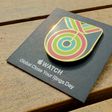Jury Foreman in Apple vs. Samsung Case Speaks to Rationale for Verdict
With the landmark Apple vs. Samsung patent and design lawsuit resulting a $1 billion verdict for Apple late last week, considerable discussion about the jury's decision-making process has been making the rounds. Several members of the jury, including foreman Velvin Hogan, gave interviews after the trial, but a new video interview of Hogan by Bloomberg Television's Emily Chang provides some additional insight into the jury's thinking. The nearly 17-minute segment covers a number of topics including the jury dynamics, calculation of damages, and how Hogan's own experience with patents and financial statements helped guide the discussion and evaluation.

Hogan notes that he initially thought the case might swing Samsung's way as the jury initially had some difficulty assessing how the validity of the patents should be decided and applied to the case.
We were at a stalemate, but some of the jurors were not sure of the patent prosecution process. Some were not sure of how prior art could either render a patent acceptable or whether it could invalidate it. What we did is we started talking about one and when the day was over and I was at home, thinking about that patent claim by claim, limit by limit, I had what we would call an a-ha moment and I suddenly decided I could defend this if it was my patent…And with that, I took that story back to the jury and laid it out for them. They understood the points I was talking about and then we meticulously went patent by patent and claim by claim against the test that the judge had given us, because each patent had a different legal premise to judge on. We got those all sorted out and decided which ones were valid and which ones were not.
Hogan also reiterates the jury's view that
comments by Google demanding that Samsung tweak its product designs to look less similar to the iPhone and iPad were particularly damning, indicating that Samsung's infringement was willful as it took in Google's advice and opted not to follow it.
Overall, the jury found that the evidence in the case "spoke overwhelmingly" to Samsung's infringement, with the jury having put "each side to the test" equally in weighing both validity and infringement claims, working through each of the involved devices and claimed infringements to reach the $1 billion verdict. Hogan also walks through how that dollar amount was reached, using their own calculations of how much Apple lost in profits from sales of the infringing Samsung devices and then adding in royalty amounts to achieve a final number.
Popular Stories
Despite being more than two years old, Apple's AirPods Pro 2 still dominate the premium wireless‑earbud space, thanks to a potent mix of top‑tier audio, class‑leading noise cancellation, and Apple's habit of delivering major new features through software updates. With AirPods Pro 3 widely expected to arrive in 2025, prospective buyers now face a familiar dilemma: snap up the proven...
Apple plans to release an all-new super thin iPhone this year, debuting it alongside the iPhone 17, iPhone 17 Pro, and iPhone 17 Pro Max. We've seen pictures of dummy models, cases, and renders with the design, but Lewis Hilsenteger of Unbox Therapy today showed off newer dummy models that give us a better idea of just how thin the "iPhone 17 Air" will be.
The iPhone 17 Air is expected to be ...
If you missed the video showing dummy models of Apple's all-new super thin iPhone 17 Air that's expected later this year, Sonny Dickson this morning shared some further images of the device in close alignment with the other dummy models in the iPhone 17 lineup, indicating just how thin it is likely to be in comparison.
The iPhone 17 Air is expected to be around 5.5mm thick – with a thicker ...
A developer has demonstrated Windows 11 ARM running on an M2 iPad Air using emulation, which has become much easier since the EU's Digital Markets Act (DMA) regulations came into effect.
As spotted by Windows Latest, NTDev shared an instance of the emulation on social media and posted a video on YouTube (embedded below) demonstrating it in action. The achievement relies on new EU regulatory...
Apple's iPhone development roadmap runs several years into the future and the company is continually working with suppliers on several successive iPhone models simultaneously, which is why we often get rumored features months ahead of launch. The iPhone 17 series is no different, and we already have a good idea of what to expect from Apple's 2025 smartphone lineup.
If you skipped the iPhone...
Apple seeded the third beta of iOS 18.5 to developers today, and so far the software update includes only a few minor changes.
The changes are in the Mail and Settings apps.
In the Mail app, you can now easily turn off contact photos directly within the app, by tapping on the circle with three dots in the top-right corner.
In the Settings app, AppleCare+ coverage information is more...
While the iPhone 17 Pro and iPhone 17 Pro Max are not expected to launch until September, there are already plenty of rumors about the devices.
Below, we recap key changes rumored for the iPhone 17 Pro models as of April 2025:
Aluminum frame: iPhone 17 Pro models are rumored to have an aluminum frame, whereas the iPhone 15 Pro and iPhone 16 Pro models have a titanium frame, and the iPhone ...






















